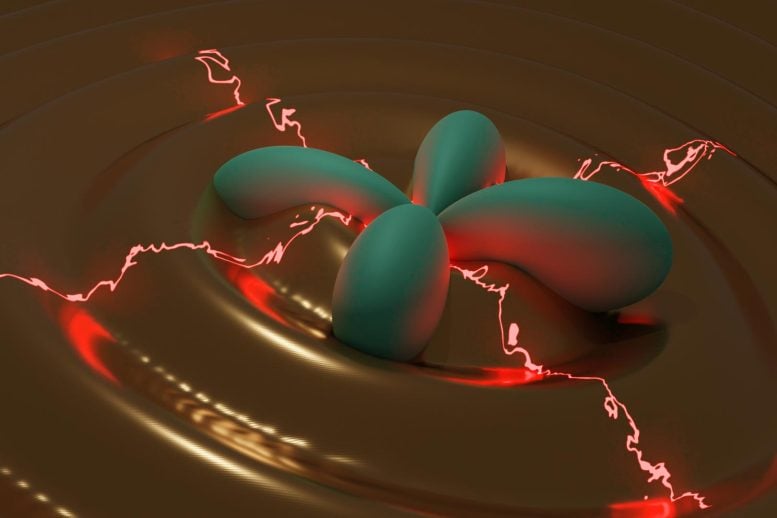MIT physicists have detected a hybrid particle in an unusual, two-dimensional magnetic material. The hybrid particle is a mashup of an electron and a phonon. Credit: Christine Daniloff, MIT
The discovery could offer a route to smaller, faster electronic devices.
In the particle world, sometimes two is better than one. Take, for instance, electron pairs. When two electrons are bound together, they can glide through a material without friction, giving the material special superconducting properties. Such paired electrons, or Cooper pairs, are a kind of hybrid particle — a composite of two particles that behaves as one, with properties that are greater than the sum of its parts.
Now
An artist’s impression of electrons localized in d-orbitals interacting strongly with lattice vibration waves (phonons). The lobular structure depicts the electronic cloud of nickel ions in NiPS3, also known as orbitals. The waves emanating from the orbital structure represent phonon oscillations. The red glowing stripes indicate the formation of a bound state between electrons and lattice vibrations. Credit: Emre Ergecen
The results are especially relevant, as the team identified the hybrid particle in nickel phosphorus trisulfide (NiPS3), a two-dimensional material that has attracted recent interest for its magnetic properties. If these properties could be manipulated, for instance through the newly detected hybrid particles, scientists believe the material could one day be useful as a new kind of magnetic semiconductor, which could be made into smaller, faster, and more energy-efficient electronics.
“Imagine if we could stimulate an electron, and have magnetism respond,” says Nuh Gedik, professor of physics at MIT. “Then you could make devices very different from how they work today.”
Gedik and his colleagues have published their results on January 10, 2022, in the journal Nature Communications. His co-authors include Emre Ergeçen, Batyr Ilyas, Dan Mao, Hoi Chun Po, Mehmet Burak Yilmaz, and Senthil Todadri at MIT, along with Junghyun Kim and Je-Geun Park of Seoul National University in Korea.
Particle sheets
The field of modern condensed matter physics is focused, in part, on the search for interactions in matter at the nanoscale. Such interactions, between a material’s atoms, electrons, and other subatomic particles, can lead to surprising outcomes, such as superconductivity and other exotic phenomena. Physicists look for these interactions by condensing chemicals onto surfaces to synthesize sheets of two-dimensional materials, which could be made as thin as one atomic layer.
In 2018, a research group in Korea discovered some unexpected interactions in synthesized sheets of NiPS3, a two-dimensional material that becomes an antiferromagnet at very low temperatures of around 150 kelvins, or -123 degrees (function(d, s, id){
var js, fjs = d.getElementsByTagName(s)[0];
if (d.getElementById(id)) return;
js = d.createElement(s); js.id = id;
js.src = "https://connect.facebook.net/en_US/sdk.js#xfbml=1&version=v2.6";
fjs.parentNode.insertBefore(js, fjs);
}(document, 'script', 'facebook-jssdk'));
Read original article here
